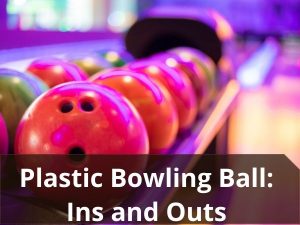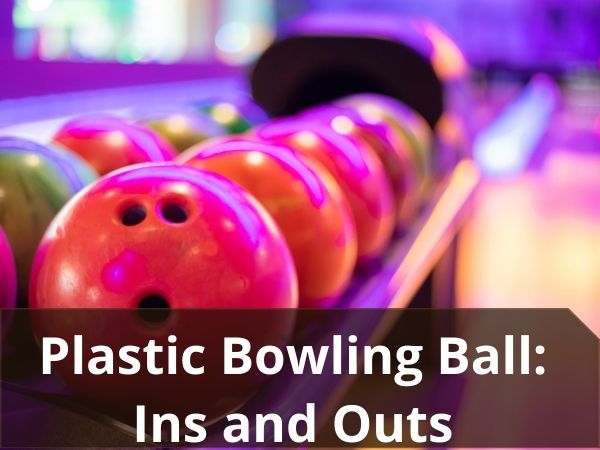Plastic bowling ball! Long before, urethane and reactive resin rules the bowling kingdom, there were plastic bowling balls. Often recognized as polyester balls, these bowling balls are perfect for beginners or casual bowlers of all ages. Understanding what to expect from a plastic bowling ball, especially how it will perform is extremely important.
Today, I have gathered all the information you need regarding plastic aka polyester bowling balls to help you understand their characteristics and mechanisms better. So without any further delay, let’s learn about plastic bowling balls in-depth.
What is a plastic bowling ball?

Simply put, Plastic bowling balls are made of plastic, nothing too fancy. So what kind of plastic is commonly used to manufacture these plastic bowling balls? Well, the most common and inexpensive material which is polyester is used to make these plastic bowling balls. This material makes the balls less sturdy than your regular urethane and reactive resin bowling balls.
Yes, the rave for plastics died down after urethane entered the market, but in recent decades, plastic bowling balls have made their way into the bowling industry and still going strong for their unique features and benefits that no other type of bowling balls can provide.
From amateurs and professionals, everyone needs at least one polyester/plastic bowling ball in their arsenal to throw it at the right time. So what’s so special about these balls? Why do people still love them? Let’s take a deeper dive into that, shall we?
Are Plastic Bowling Balls a good choice?
To be honest, that depends entirely on when you are willing to use your plastic bowling ball. If it is a sports pattern and you’re about to show the performance of your lifetime, it is better not to throw your plastic bowling balls down the lane. So when do plastic balls make the ‘right choice’?
If you’re just getting started in the world of bowling, the first thing you should get your hands on is a piece of plastic bowling equipment. Plastic bowling balls are lightweight, easy to maintain, and they hit the pins on point. These balls make an excellent choice when beginners are learning basic bowling and regular bowlers need their ball to go straight to pick up the spares. Plastic bowling balls are also great for not breaking your banks, meaning, they are pretty affordable. Why shouldn’t it be a good choice?
When to use Plastic Bowling Balls?
So when is the right time to choose plastic bowling balls? First, answer me this— do you often struggle to score a spare? I know how hard can it be to pick up the spares (singles or splits) at the end of the lane. This is when your want your ball to go straight without hooking at the breakpoint. And what kind of ball can do that successfully? A plastic bowling ball, of course.
Plastic bowling balls can also be your best friend if you’ve just started to bowl. Besides, the balls you see in your local bowling alley for casual fun bowling are mostly made of plastic/polyester. They are pretty fun to play with, not gonna lie. Plus, if you consider yourself a straight-line thrower, you will be grateful for adding a plastic bowling ball to your shopping cart. These balls are also great for kids and teens who are completely new to this game.
What Kind of Lane Conditions is Plastic Bowling Ball Good For?
Plastic balls are unaffected by the oil on the lane. Therefore, you can throw it both on wet or dry lane conditions. How amazing is that! However, it’s better not to throw them down a long sports pattern where the lanes are heavily oiled and the additional length is going to burn the power of the ball and hit the pins with a low force.
I always find plastic balls react best in dry lane conditions. They skid better with a straight trajectory and the right amount of friction. On dry lanes, the plastic balls never overreact, nor do they make a curve at the breakpoint. If you’re intending to bowl on THS, you can’t go wrong with a plastic bowling ball.
How Long Does a Plastic Bowling Ball last?
Unfortunately, plastic balls don’t last too long. Urethane and reactive resin bowling balls have special components that make them comparatively sturdier than plastic bowling balls. Due to friction and pin hitting, the ball gets weaker. Old plastic bowling balls tend to break or crack faster. Moreover, there are some poorly made plastic bowling balls you can find in the market that can even break after a few games. So make your purchase carefully. If you can get your hands on a moderately durable plastic ball, and you manage to maintain it properly, you can make them last for an indefinite time.
Pros and cons of Plastic bowling balls
Pros:
– Consistent straight shots and expected performance
– Suitable for all kinds of bowlers (the purpose of use varies)
– On-point bowling reaction (no over or underreaction)
– Easy to afford because they are cheap
– Doesn’t hook at all, hence, they are perfect for straight trajectories
– Works excellent as a spare ball
– Perfect for typical house shot oil pattern
– Just the right kind of ball when the oil on your bowling lane starts to dry up
– Doesn’t absorb the oil that gets picked up from the lane
Cons:
– Not great for power-dominant bowlers
– Prone to crack or break, so not enough durable
– Often lacks the power that is needed for strikes
– not great for heavy sports oil patterns.
FAQs Of Plastic Bowling Ball!
What is a plastic bowling ball?
- A plastic bowling ball is a type of bowling ball made primarily from polyester or urethane materials. These balls are designed for straighter shots and are often used by beginners or for specific spare shots.
How does a plastic bowling ball differ from other types of bowling balls?
- Plastic bowling balls have a lower hook potential compared to reactive resin or urethane bowling balls. They are less aggressive on the lane and are better suited for shooting spares or for bowlers who prefer a straighter trajectory.
What are the advantages of using a plastic bowling ball?
- Plastic bowling balls are durable and less prone to lane oil absorption. They are also less affected by changing lane conditions, making them a consistent choice for spare shots. They are typically less expensive than more advanced bowling ball materials.
Can I use a plastic bowling ball for strike shots?
- While plastic bowling balls are not ideal for striking as they have limited hook potential, some bowlers, especially beginners, may choose to use them for straighter shots. However, for high-scoring games and hook shots, reactive resin or urethane balls are generally preferred.
Are plastic bowling balls suitable for spare shooting?
- Yes, plastic bowling balls are often used for spare shooting due to their predictability and straight-line motion. They are commonly used for picking up corner pins, 10-pins, and other single-pin spares.
What weight options are available for plastic bowling balls?
- Plastic bowling balls are available in various weight options, typically ranging from 6 to 16 pounds, just like other types of bowling balls. Bowlers should choose a weight that is comfortable and suits their strength and playing style.
How do I take care of my plastic bowling ball?
- To maintain a plastic bowling ball, clean it regularly with a bowling ball cleaner or a microfiber cloth to remove lane oil and dirt. Store it in a cool, dry place and avoid extreme temperatures. Periodic resurfacing or polishing may be necessary to restore the ball’s surface.
Can I customize the drilling of my plastic bowling ball?
- Yes, plastic bowling balls can be customized with drill layouts to match your hand’s specifications and playing style, just like other bowling balls. It’s important to work with a skilled pro shop operator for proper drilling and fitting.
Are plastic bowling balls suitable for all skill levels?
- Plastic bowling balls are typically recommended for beginners and those who prefer straighter shots. More experienced bowlers often opt for reactive resin or urethane balls for their higher hook potential.
How much should I expect to pay for a plastic bowling ball?
- The cost of a plastic bowling ball can vary widely depending on the brand, model, and features. On average, you can find plastic bowling balls ranging from $40 to $100, making them a more affordable option compared to other types of bowling balls.
Conclusion
So there you go, my favorite bowlers! Plastic bowling balls can be very fun if you play them right. Whether you’re a new bowler or an experienced one, a piece of plastic bowling equipment is a must. Newbies learn the basics whereas you learn to fill the frames. That’s all I gotta say about plastic bowling balls. Feel free to drop a comment if you have any questions on your mind. Till then, have fun with your plastic bowling ball. Good luck!

Passionate Bowler and Bowling Enthusiast
Jess Pinelli is a dedicated bowling enthusiast with a deep love for the sport that spans over 6 years. With numerous strikes, spares, and a few gutter balls under hes belt, he has honed his skills on lanes across the country. Pinelli’s journey in the world of bowling has been a remarkable one, from casual weekend games with friends to competitive league play and even a few local tournaments.
Driven by her passion for the game, Pinelli decided to channel her expertise and knowledge into the digital realm, becoming a prolific author on this bowling website. She’s your go-to source for everything bowling-related, from mastering the perfect hook to choosing the right bowling ball and even navigating the world of bowling etiquette.
When she’s not busy writing informative articles or reviewing the latest bowling gear, you’ll likely find Pinellis at her favorite local bowling alley, helping newcomers improve their game or enjoying some friendly competition with fellow bowlers. She firmly believes that bowling is not just a game but a community, and she’s committed to fostering that sense of camaraderie both online and offline.




